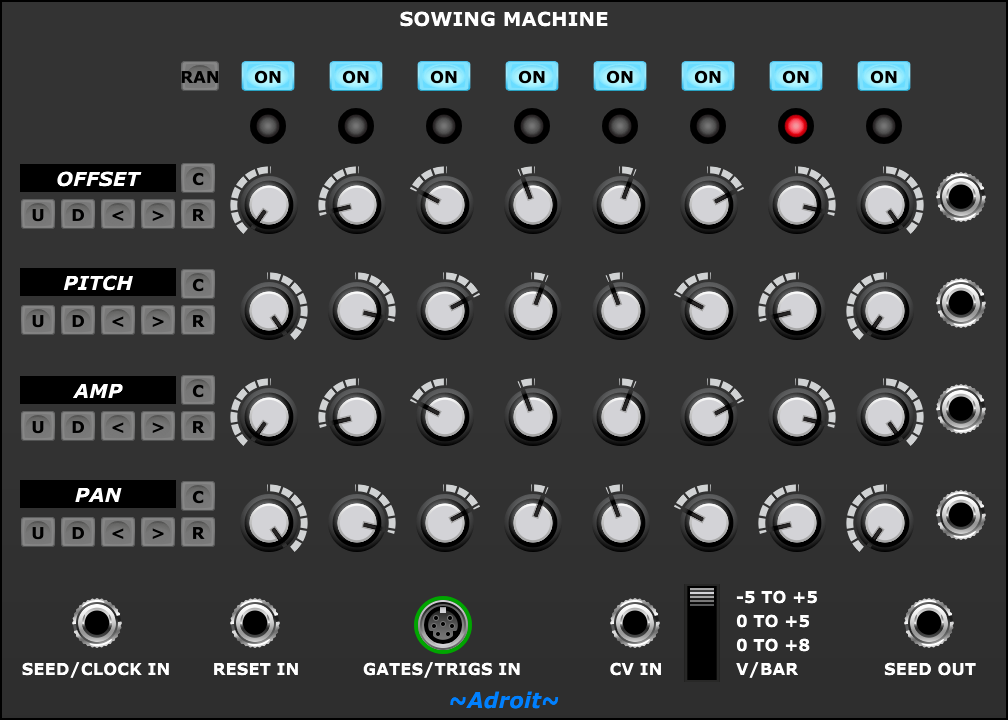
!Draft Documentation of an early prototype!
The module is a highly specialized 8 step sequencer designed to work closely with the Adroit Granular Synth.
Its four channels are generally assigned to parameters in the Granular Synth (although each channel’s CV output is available for more general use).
If four channels aren’t sufficient then you can use several Sowing Machines wired in parallel.
Which sequencer step is active at any one time depends on how the module is connected as described below.
Serial Seeding Modes
Clocked Sequencing
If SEED/CLOCK IN is connected then the sequencer advances one step when a trigger is received just like any regular sequencer. The SEED/CLOCK IN socket is most often connected to the SEED OUT socket of a Granular Synth so that the sequencer advances to a new step each time a new grain is seeded. This provides you with the means to sequence grain parameters at a microscopic level and opens up all kinds of interesting possibilities.
However, signals in a patch take a small amount of time to propagate between modules so once the Sowing Machine has received a seeding trigger from the SEED OUT socket of a Granular Synth, advanced to the next step and changed its outputs to the values of the next step, the Granular Synth has already seeded a new grain with the previous modulation values. At high seeding rates this is of little concern but at slow seeding rates it’s frustrating as the Granular Synth lags one step behind the Sowing Machine.
To fix this the Sowing Machine passes on the signal it receives via its SEED/CLOCK IN socket to its SEED OUT socket but delayed by tiny amount of time. This delay is measured in microseconds and is totally imperceptible but it is sufficiently long for the Sowing Machine and Granular Synth to work in perfect sync providing you connect the Sowing Machine’s SEED OUT socket to the Granular Synth’s SEED IN socket.
Sequencing need not always be at regular rates or at high speeds. You could for instance connect the MOUSE GATE output of the Granular Synth Breakout module to SEED/CLOCK IN so that the sequence advances only when you click on the Granular Synth’s waveform display.
A trigger sent to the RESET IN socket resets the sequence to the first step. You might use this to sync a micro sequence to a gate signal being fed to the Granular Synth so that individual notes start in the same state.
Voltage Controlled Sequencing
If CV IN is connected it overrides any SEED/CLOCK IN signals and puts the Sowing Machine into voltage controlled mode. You might use this mode in combination with the Granular Synth Breakout module as it enables you to use any of a Granular Synth’s modulation sources to control the sequencer.
When voltage controlled rather than advancing left to right in clockwork style the sequence behaves in a fashion more like LSSP sequencers. Indeed if you set the switch to V/BAR it behaves exactly like an LSSP sequencer. So you can use Time Splitting to chain multiple Sowing Machines together. There’s no merge facility but all outputs drop to zero when V/Bar drops to zero so you can just wire things up in parallel. An example patch will follow.
The slide switch to the right of the CV IN socket enables you to select how the voltage from the CV IN socket maps to the 8 steps of the sequencer.
-5 TO +5
This setting maps regular bipolar signals such as the LFOs in Granular Synth to the eight steps. So -5 V maps to step 1 and +5 V maps to step 8.
0 TO +5
This setting maps regular unipolar signals such as the Envelope Generator in Granular Synth to eight steps. So 0 V maps to step 1 and +5 V maps to step 8.
0 TO +8
This is like 0 TO +5 but intended for use with the GRAIN NOTE output from Granular Synth Breakout to automatically map logical note values from the Granular Synth arpeggiator to steps. This is a very powerful feature as it enables you to precisely dial in separate parameters for each note in an arpeggio or a granular chord. So for instance a channel controlling PAN enables you to pan each note in an arpeggio or chord to a particular position in the stereo image.
Note this only works when the Granular Synth pitch quantization mode is D or U as otherwise the arpeggiator is disabled.
When using GRAIN NOTE for CV IN it’s best to think about the Sowing Machine as operating in columns rather than rows – with each column corresponds to a note.
V/BAR
As already mentioned the Sowing Machine can operate exactly like any sequencer in LSSP when in V/BAR mode. So if the CV IN signal is 0 V then it goes to sleep and all outputs are 0 V. A CV IN voltage of 1 V maps to step 1 and then every 1/8th volt increase maps to a higher step before things wrap around at 2 V.
So a regular V/Bar signal maps the steps of the Sowing Machine to one bar with each step corresponding to an 1/8th note within the bar. As is always the case in LSSP you can use a Time Flow Changer module to change this relationship.